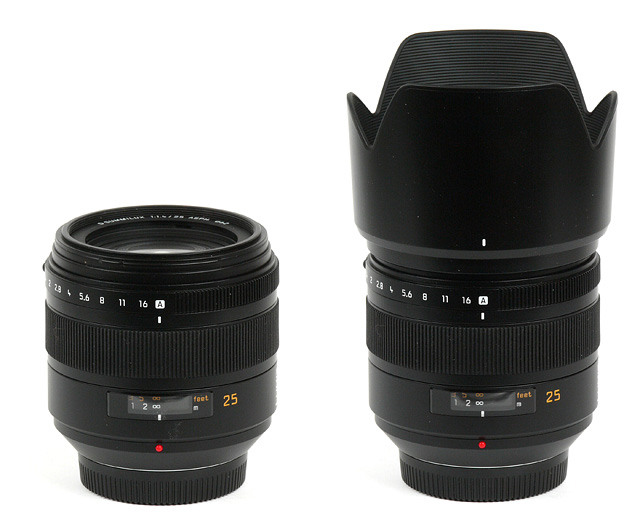|
Leica D Summilux 25mm f/1.4 - Review / Test Report |
|
Lens Reviews -
(Micro-)Four-Thirds
|
|
Page 1 of 3

Review by Klaus Schroiff, published April 2010
Introduction
The Leica D Summilux 25mm f/1.4 is a member of the rare species of four-thirds lenses made by Panasonic. It's actually a fairly recently released lens but Panasonic wasn't overly fortunate regarding their four-thirds ventures. It seems likely that they'll focus on micro-four thirds EVIL cameras so their "classic" four-thirds lenses may not be around for much longer. Anyway, apart from carrying the prestigious Leica label the 25mm f/1.4 is also interesting due to its ultra-large aperture (the term "Summilux" refers to Leica lenses with an aperture of f/1.4 in case your wonder). Such (native) lenses are quite scarce in four-thirds land - only the Sigma AF 30mm f/1.4 EX and AF 50mm f/1.4 EX are as fast here. The Leica lens isn't exactly a budget item - it sells for around 800EUR/US$ ... if you can find one to start with. However, here at OpticalLimits we're often feeling that itch when such exotics are offered to us for testing so let's have a look whether the 25mm f/1.4 lives up to the Leica legend.

Four-thirds lenses tend to be quite small due to the smaller image frame that they need to cover. However, the Leica lens is comparatively big and heavy - it's just slightly more compact and light weight than e.g. a Canon EF 24mm f/1.4 USM L II or a Nikkor AF-S 24mm f/1.4 G ED which are both full format lenses. The build quality is excellent thanks to a tightly assembled combination of metal and (a few) high quality plastic parts. The rubberized focus rings operates smooth and slightly damped. The physical size of the lens remains constant regardless of the focus setting. The front element does not rotate thanks to a rear-focusing system. A quite exotic feature is the aperture ring which is located at the front of the lens but the aspect is only supported by native Panasonic DSLRs such as the L10.
 The Leica lens has a conventional AF micro-motor. The AF speed is Okay but it's not a speed daemon. The AF accuracy is very good at least based on the tested sample. The AF noise emissions are fairly low. Live-View is fairly slow but that's more a camera issue of course. A focus distance scale window is provided. Manual focusing works "by wire" so the focus ring is actually coupled to the AF motor - it's a matter of taste whether you like this approach but we've had no problems with it here. The lens may also be interesting for micro four-thirds users - the AF remains functional when using one of the Olympus/Panasonic adapters. The AF speed is fine here.
The Leica lens has a conventional AF micro-motor. The AF speed is Okay but it's not a speed daemon. The AF accuracy is very good at least based on the tested sample. The AF noise emissions are fairly low. Live-View is fairly slow but that's more a camera issue of course. A focus distance scale window is provided. Manual focusing works "by wire" so the focus ring is actually coupled to the AF motor - it's a matter of taste whether you like this approach but we've had no problems with it here. The lens may also be interesting for micro four-thirds users - the AF remains functional when using one of the Olympus/Panasonic adapters. The AF speed is fine here.
| Specifications |
|---|
| Equiv. focal length | 50 mm (full format equivalent) |
| Equiv. aperture | f/2.8 (full format equivalent, in terms of depth-of-field) |
| Optical construction | 10 elements in 9 groups inc. 1x aspherical, 1x Super-ED and 3x ED elements |
| Number of aperture blades | 7 (circular) |
| min. focus distance | 0.38 m (max. magnification ratio 1:11) |
| Dimensions | 75 x 78 mm |
| Weight | 510 g |
| Filter size | 62 mm (non-rotating) |
| Hood | petal-shaped, snap-on, supplied |
| Other features | aperture ring |
|